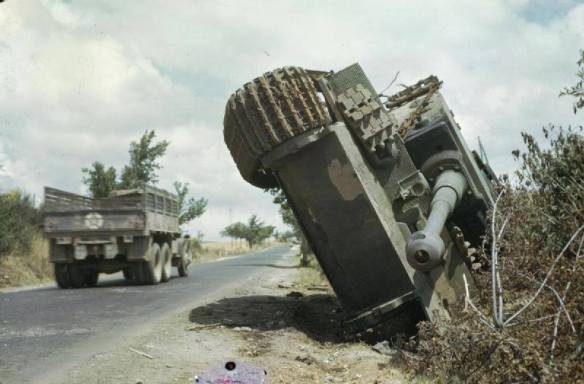ITALY – Tiger of schwere Panzer-Abteilung 508 destroyed 25 May 1944 following mechanical problems near the town of Giulianello then pushed on the side of the road by the advancing 5th Army.
The 3.Kompanie/schwere Panzer-Abteilung 508 was also committed to stopping the Allied drive. They lost almost all of their Tigers, as related in the following report on their activities between 23 and 25 May 1944 in the general area of Cisternia.
The 3.Kompanie, which had brought down 14 Tigers from France, lost two burned out at the end of February 1944 one through carelessness on the part of the crew and another by Allied anti-tank action. A driver had not paid attention to the tightness of fuel line joints, and fuel leaking onto the floor of the Tiger was ignited by a discarded cigarette butt. The crew got out unharmed, but the Tiger was a total write-off. The incident was glossed over but would have had serious consequences on home service, for crews were strictly warned not to smoke inside a Panzer, and drivers in particular are told, “Be careful, you’ve got a million marks and three and a half million working hours under your ass.”
The 3.Kompanie received four of the latest pattern Tigers during May 1944 and was two tanks over the authorized K.St.N. strength on 23 May 1944, i.e., 16 instead of 14.
The order was given to move without speed restrictions to counterattack American forces advancing from the beachhead and seeking to join up with troops pushing toward Rome from the south.
The 3.Kompanie formed up behind the railway embankment between the Mussolini Canal (Point 43) and the level crossing and engaged troop concentrations with Sprenggranaten. It then crossed the embankment. Three Tigers broke down in the attempt (one with transmission trouble and two with tracks riding over the sprocket teeth).
The remaining 13 crews all had to stop on open ground because their guns had dug into the ground when the Tigers descended the steep embankment, and needed to be cleaned out.
The Allied troops were driven back about 3 kilometers and a number of Sherman tanks were surprised and knocked out. The first loss sustained in action was a Tiger which had one radiator destroyed by an artillery round and had to limp back toward Cori in stages. Twelve Tigers were thus left in action during the night of 23/24 May 1944.
On the morning of 24 May 1944, to everyone’s surprise a retreat was ordered and anti-tank fire accounted for one Tiger (hit on the right final drive and subsequently blown up by its crew).
Eleven Tigers withdrew to the embankment and the 3.Kompanie commander ordered five Tigers to continue to hold the enemy while six were used to tow away the three Tigers which originally had failed to cross. Four of the six towing Tigers experienced transmission trouble, and the commander then ordered the three towed Tigers to be destroyed. Two of the five operational Tigers assisted in towing away the new breakdowns.
These eight Tigers got back to an assembly point near Ouri, leaving only four Tigers in fighting order. Of these four, one was hit by anti-tank fire and two more experienced transmission trouble (all three were blown up), so that only one operational Tiger was left.
Two converted Sherman tanks came down from Rome during the night of 24/25 May 1944 and extricated the last operational Tiger, which had also broken down in the meantime, by towing it in tandem along the railway track.
By 24 May 1944, the situation had deteriorated so much that it was manifestly impossible to get towing vehicles through, and the 3.Kompanie commander ordered that the nine Tigers which had reached the assembly area be blown up.
Although a good many of the crews had gone back to Rome with the one operational Tiger, the commander and about 45 men were left near Corio They had to march back to Rome and came under fire several times in the process, surviving in an exhausted condition.
